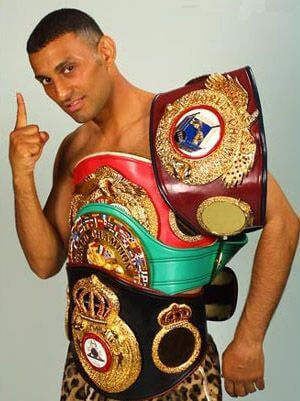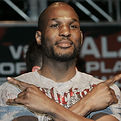BoxingAcademyOnline.com

Naseem Hamed
A Boxing Icon
When discussing iconic figures in boxing, Prince Naseem Hamed is a name that stands out not only for his talent and achievements but also for his flamboyant style and unmatched charisma. Known for his lightning-fast reflexes, knockout power, and entertaining entrances, Naseem Hamed revolutionized the featherweight division in the 1990s and left a lasting legacy in the world of boxing. This article explores his life, career, and impact, offering a deep insight into the man who was once considered boxing royalty.
Story
Early Life and Origins of a Prince :
Naseem Hamed was born on February 12, 1974, in Sheffield, South Yorkshire, England, to Yemeni parents. Raised in a working-class Muslim household, Hamed's upbringing was modest. His parents recognized his energy and determination early on, and by the age of 7, he began training in boxing under Brendan Ingle at the Wincobank gym in Sheffield.
Ingle quickly saw potential in the young Hamed, molding him with an unorthodox fighting style that blended speed, head movement, and unshakable confidence. The trainer’s guidance laid the foundation for a boxing style that would mesmerize fans and frustrate opponents for years.
Turning Pro: The Rise Begins :
Prince Naseem Hamed turned professional in 1992 at the age of 18. His early fights were marked by flashy ring entrances, acrobatic movements, and devastating knockouts. With an unorthodox southpaw stance and razor-sharp reflexes, he became a nightmare for traditional fighters.
Within just a few years, he captured the attention of the boxing world. His flamboyant persona and explosive performances made him a television favorite. Broadcasters, especially Sky Sports and later HBO, began featuring his fights prominently.
World Champion: The Featherweight King:
In 1995, Hamed won his first world title — the WBO featherweight belt — by defeating Steve Robinson in Cardiff, Wales. The fight was a masterclass, showcasing Hamed’s speed and power as he stopped Robinson in the eighth round. This victory marked the beginning of his dominance in the featherweight division.
Hamed successfully defended his title multiple times, defeating notable opponents such as:
-
Manuel Medina
-
Wilfredo Vazquez
-
Kevin Kelley (in a dramatic fight at Madison Square Garden)
-
Wayne McCullough
-
Paul Ingle
Each fight solidified his reputation not only as a dominant boxer but as one of the most entertaining athletes of his time.
The Kelley Fight: A Battle for the Ages :
One of Hamed’s most legendary bouts came in 1997 against American boxer Kevin Kelley. Taking place in New York’s Madison Square Garden, this was his U.S. debut — and what a debut it was. The bout featured six knockdowns in total, with Hamed ultimately knocking out Kelley in the fourth round.
This fight showcased everything that made Hamed special — vulnerability, courage, showmanship, and devastating finishing ability. It was also a major breakthrough for British boxers seeking recognition in the American market.
Style and Showmanship: A Brand of His Own :
Hamed wasn't just a boxer — he was a performer. His ring entrances were legendary, featuring pyrotechnics, flying carpets, and even levitating platforms. He often danced on his way to the ring, taunting opponents and thrilling fans.
In the ring, his reflex-based defense and unpredictable angles gave him a unique edge. He kept his hands low, relied on head movement, and threw punches from unconventional angles — often knocking out opponents with a single, unseen shot.
The Barrera Defeat: A Turning Point :
In 2001, Hamed faced Mexican legend Marco Antonio Barrera in Las Vegas. In a fight where Hamed was the heavy favorite, Barrera dominated with superior tactics, discipline, and pressure. Hamed lost via unanimous decision, suffering the first and only defeat of his professional career.
The loss was significant not only for the title but for Hamed's aura of invincibility. After the defeat, his passion for the sport seemed to decline, and he fought only once more — a win against Manuel Calvo in 2002 — before retiring.
Retirement and Life After Boxing :
Naseem Hamed officially retired in 2002 with a professional record of 36 wins (31 by knockout) and 1 loss. Despite the early end to his career, his impact remained immense.
Post-retirement, Hamed focused on personal life, family, and business ventures. He also faced some legal troubles, including a prison sentence in 2006 related to a dangerous driving incident. However, he remained a prominent figure in British boxing culture.
In 2015, he was inducted into the International Boxing Hall of Fame, cementing his legacy as one of the sport’s greats.
Legacy and Influence :
Prince Naseem Hamed is credited with revolutionizing the featherweight division. His style influenced a generation of fighters, including stars like Tyson Fury and Josh Warrington, who admired his confidence and unorthodox approach.
He also broke barriers for Muslim and Arab athletes in the West, proudly displaying his faith and background. His success opened doors for fighters from underrepresented communities, inspiring young boxers globally.
Conclusion: The Legend of Prince Naseem:
Though his career ended sooner than many expected, Prince Naseem Hamed’s impact on boxing remains timeless. With an electric personality, unmatched ring talent, and global appeal, he became one of the most memorable figures in boxing history.
Whether remembered for his knockout power, his flashy entrances, or his unwavering confidence, Prince Naseem will forever be “The Prince of the Ring.”
he world of sport.

Website Contents
The contents by the website
.jpg)



.webp)
%20(1).webp)
Contact
I'm always looking for new and exciting opportunities. Let's connect.
123-456-7890



